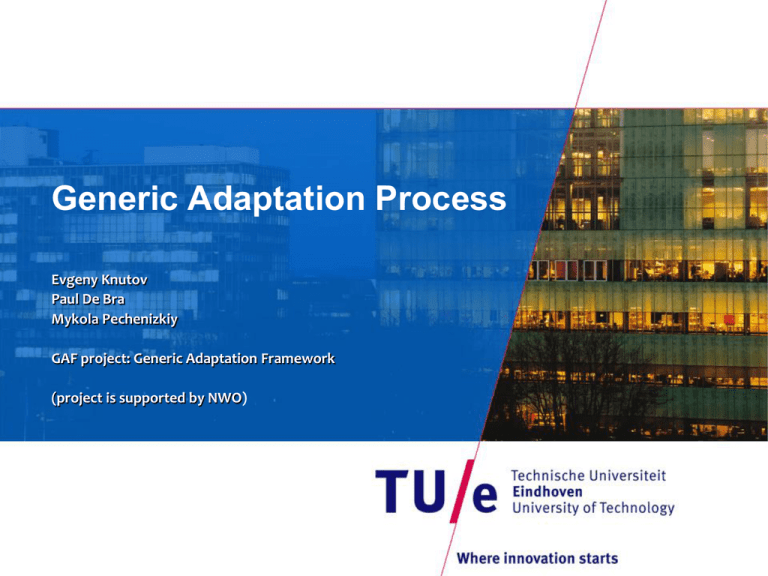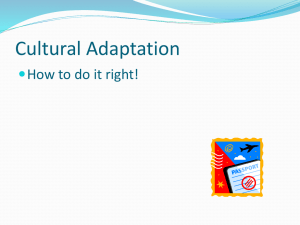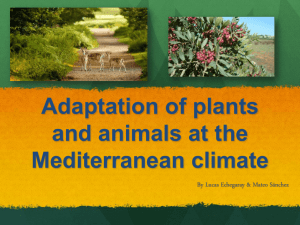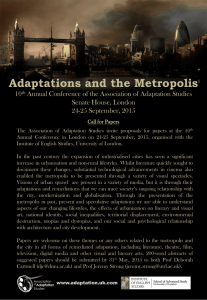Presentation
advertisement

Generic Adaptation Process Evgeny Knutov Paul De Bra Mykola Pechenizkiy GAF project: Generic Adaptation Framework (project is supported by NWO) Agenda • • • • • • • • Adaptation process modeling AH classification and adaptation cycle AHS evolution GAF layers Generic Flowchart GAF sequence chart Use-cases Conclusions / Department of Computer Science 9-4-2015 PAGE 1 Adaptation process modeling: Classic loop user modeling - adaptation Generic Adaptivity Model GOMAWE Munich Model: Lifecycle of Adaptation / Department of Computer Science 9-4-2015 PAGE 2 Classification of AH methods and techniques; adaptation process highlights: • Classification of AH methods and techniques integrated with adaptation process cycle • Basis for the AHS layered structure / Department of Computer Science 9-4-2015 PAGE 3 AHS evolution: • Generalize AHS functionality in GAF • Enhance GAF layered structure with the process • Generalize adaptation process in GAF / Department of Computer Science 9-4-2015 PAGE 4 Rotating GAF layered model: • GAF aligns the order of the layers in the system according to the classification of AH methods and techniques • Rotate layered structure of GAF and match with adaptation process flowcharts GAF layered structure / Department of Computer Science 9-4-2015 PAGE 5 Adaptation process: • • • • • • Generic representation of the process Aligned it with the traditional ‘adaptation questions’ Provides a flowchart diagram of a generic AHS Align the layers of AHS in a sequence chart Matched flow and sequence charts Reference Adaptation Process / Department of Computer Science 09/04/2015 PAGE 6 Generic Flowchart (example): (4) saving goal to follow in UM current user goal is prestored in UM preparing instance of UM to work with and current goal (acquiring full user profile) (5) • 3 main blocks: acquiring next concept (void in case one-at-a-step adaptation) + associated events adaptation condition true false concept-content-adaptation interaction triggering a rule (from rule repository) acquiring corresponding content/frame/info unit acquiring corresponding content (info units) processing information unit (content/links from frames/ pages/ etc.) (8) Adaptation Model applying adaptation techniques (7) (6) presentation generation showing info/content to the user Presentation Model navigation adaptation ... content adaptation (4) update user knowledge/ properties store intermediate user progress User model proceed to the next step • goal acquisition, • adaptive functionality • test-feedback loop • Mapped on the layered structure of GAF model • Mapped on the Adaptation process sequence chart (see process numbers and GAF sequence chart further) updating user goal progress / Department of Computer Science 9-4-2015 PAGE 7 Key elements of GAF sequence chart: • Layered structure preserved in a sequence • Layers aligned with adaptation questions • Layers aligned with process and generic flowchart • Layers determine (de) composition of the GAF model / Department of Computer Science 9-4-2015 PAGE 8 GAF sequence chart: Classification of AH Methods and Techniques; adaptation process highlights When? To What? What? How? Where? Defining user (1) goal Passing content to be rendered and presented Aligning goal with (2) Domain Model Initiating adaptation (3) Presentation Model (6) Application Model User Model Domain Model UM-DM overlay sustainability (4) Adaptation Model Retrieving/updating UM state Retrieving concept corresponding domain (5) information (hierarchy, resources, meta data, etc.) Context Model Goal Model (7) Invoking adaptation methods and techniques Interaction requires reply Acquiring resources (content) for the concept (8) User Context Defining usage context Group (9) formation / Department of Computer Science Usage Context Passing data/ control to other sub-system Maintaining and Acquiring Adaptive rules of higher order Considering usage context Maintaining and updating HOA with system usage data Group Model Legend: Resource Model Acquiring user context Higher Order Adaptation Why? 9-4-2015 PAGE 9 Use-case 1: Adaptive course: user states goal User stated goal is translated into system internal goal (from what user chooses (link, project, etc.) to system conceptual representation) translating goal into system internal presentation goals acquisition/projects, etc. (mapped from DM) acquiring next step: (goal/test/ concept) Resources repository content acquisition required granularity module (detailed elaboration) overlay DM elaboration? not req. rules repository goal (detailing, hierarchy, trail) concept adaptation (content/concept AE functionality) tests UM Rules repository: 1) concept adaptation rules 2) goal elaboration rules 3) test rules (rules to organize and follow up with the test procedures) Can be considered as a part of AE UM concept-content adaptation sequence (see Figure 10) UM retrieve/update go to the next step of adaptation, elaboration acquiring rules presentation generation (content sequence/goal sequence, etc.) In case goal or concept structure is not detailed enough – goal elaboration rules will be applied ‘next’ goal / concept / test main loop granularity module concept-content adaptation sequence presentation generation yes Adaptation finished? Granularity module • Generic Flowchart compliance As an output we have: - detailed goal sequence (matched with project, etc) - detailed sequence of content chunks, frames, etc. - test sequence (covering designated course) / Department of Computer Science 9-4-2015 PAGE 10 Use-case 2: WWW Search: • Sequence chart (GAP) compliance with the search process: • • • • Goal Model – defines search query Domain Model – defines search index Resource model - WWW Context Models – defines user and usage context properties (IP, user profile, etc.) • Group Model – defines user collaborative profile • Adaptation and Application models – define search engine and ranking mechanisms / Department of Computer Science 9-4-2015 PAGE 11 Use-case 2: WWW Search sequence chart: User Profile AHS Overlay Model Defining User – stating the query user goal Ranking Passing content to be rendered and presented Interpreting Query (refolmulation, extern lex., etc.) Initiating adaptation AH methods and techniques Acquiring resources for the concepts / Department of Computer Science www Group formation Maintaining collaborative profile User Context Usage Context index Search Defining the and Result usage context history Group Model Crawler Resource Model IP, profile, etc. Considering usage context Adaptation Model Acquiring user context Application Model Context Model UM-DM overlay sustainability Invoking adaptation Methods and techniques Accumulating user search history Retrieving/updating UM state User Model Domain Model Goal Model parsing query Retrieving concept corresponding domain information (hierarchy, resources, meta data) User Interface: Presenting search results, snippets, ranking info., etc. Presentation Model Aligning goal with the Domain Search Engine Maintaining and Acquiring Adaptive rules of higher order Maintaining and updating HOA with system usage data 9-4-2015 Higher Order Adaptation Search Query PAGE 12 Conclusions: • Generic Adaptation Process • Conformity of the adaptation process sequence and flowchart approaches • Layered process-based (de)composition of an adaptive system • Building Block of a User-Adaptive System process / Department of Computer Science 9-4-2015 PAGE 13 Further work: • Elaborate process description and extend generic adaptation process emphasizing new developments in AH • Align adaptation sequence chart with other useradaptive systems (e.g. Recommender systems) • Emphasize interoperability of the new AH developments in the context of the process (e.g. open corpus adaptation, higher order adaptation, etc.) / Department of Computer Science 9-4-2015 PAGE 14 Thanks! and Questions? / Department of Computer Science 9-4-2015 PAGE 15









